- What’s the Difference between Sanitary Filters and Strainers?
- How is Sanitary Fitting Different from other Stainless Steel Pipe Fittings
- Trademark Disclaimer
- Sanitary Fitting Part Numbers- A Cross Reference Guide
- BPE and 3A Sanitary Fittings- What’s the Difference?
- Actuators Selection for Sanitary Hygienic Valves
- Stainless Steel Sanitary Fittings, Valves & More
- Maxpure Stainless History:
Sometimes, during your brewery, beverage, milk, cosmetic processing, you have a process that has some particulates in it. You know that you want some or all of these particulates out of the product before you proceed with manufacturing, but you’re not sure how to get started. Do you need sanitary filters or strainers? What is the difference between filtering and straining anyway in sanitary processing? What does it all mean?
These questions are not uncommon, and knowing who to talk to can help you make a confident choice. The presence of unwanted particulates can greatly influence your finished product, so keep in mind that “unwanted particulates” does not always refer to foreign matter. Sometimes we are talking about foreign matter (that enters your process line from the outside environment) and sometimes we are simply referring to particulates that may have formed during normal production conditions.
Each process is different, and the impact of unwanted particles varies. Some concerns are with the consistency of the finished product. Maybe the flavor profile will be off, or maybe the particulates will foul up dispensers or fillers later on down the line. No matter where the concern stems from, it usually is a very real concern.
This gives us a good vantage point to view the problem and clarify exactly what you need. What do you want removed from the product? How large are the particulates in question? These questions can determine whether you need to consider filtering or straining. Filtering refers to a finer removal process. Filters usually employ some form of “sock” or cartridge that has the ability to remove small particles down to the size of fine sand, or even microbials.
Filter Socks
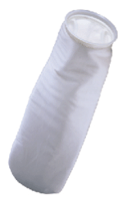
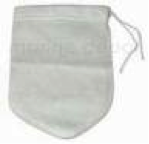
Strainer
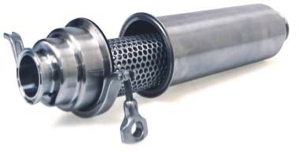
Straining is generally considered a much coarser operation and is usually employed to catch larger chunks, a quarter inch or so. Think of straining as your colander for spaghetti noodles, while filtering is the paper filter you use for coffee grounds. If you tried to use a colander for coffee grounds you would likely be disappointed in the quality of the finished product. In the same way, if you tried to use a coffee filter to strain the water off your spaghetti noodles, it would take a long time to move the water along, and you may damage the filter beyond repair in the process.
Like many application issues, the exact line where you cross over from filtering to straining is ambiguous, and other factors must be taken into consideration. Choosing the wrong filter material may lead to a pressure drop across the filter so severe that fillers downstream no longer have sufficient product pressure. Over-pressurizing the filter/strainer housing can lead to premature failure of the components, up to and including, collapsing the housing itself.
As for the measurement units you will encounter, you might see mesh or micron. Which rating is appropriate for your situation? While these units can seem different, they are at least analogous to one another. That is to say, 35 mesh is a size that is roughly equivalent to 500 micron. Think of mesh and micron in the same way as you think of Fahrenheit and Celsius. They refer to the same thing, but they are two different ways of saying it. In general, mesh will be used where larger orifices and straining exists. Micron will typically be used where much smaller openings are desired and filtering is what is needed.
Mesh
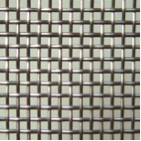
By definition, a micron is a unit of measure equal to one millionth of a meter. Mesh (which actually refers to square mesh) means the number of “squares” is the same in either direction and is typically per some unit length. For example, three squares per inch is three mesh. When you think through these comparisons you can mathematically arrive at how these two units are always tied to one another.
Vee-Wire®
(Visually similar to Wedgewire)
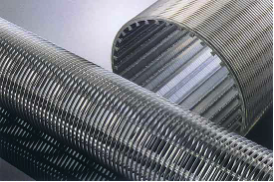
You have likely heard of Vee-Wire® or Wedgewire when talking about filters and strainers, but you may not know what the difference is, or if you even need to worry about the difference. Vee Wire and wedge wire inserts are typically used in applications where a more robust design is required. They offer more in the way of support with regards to viscous products. As you can imagine, a filter sock needs a support ring or mechanism to keep it in place, but a heftier Vee-Wire screen will not typically need any additional support inside the housing.
Important questions to consider
What does the process dictate?
What do you need to get your operation up and running?
What process parameters do you have to adhere to?
How important is it to get all of the particles out of the product?
At the end of the day, it is all about spacing. Each of the different filter/strainer methods or media mentioned above is similar in the fact that it simply reduces the spacing allowed for product to move through. The process parameters usually dictate a fairly clear path to an appropriate filter/strainer. If you know the right questions to ask, you can find a deeper solution that can prevent potential hang-ups in the future.
If you have questions about a particular application, leave your comments and I will get back with you promptly. In the immortal words of Albus Dumbledore: “…help will always be given at Hogwarts to those who ask for it.”
Next: How is Sanitary Fitting Different from other Stainless Steel Pipe Fittings







